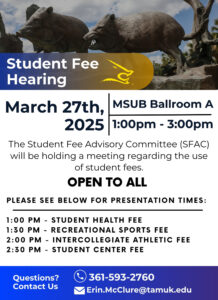Spring 2016 marked a turning point for enrollment at the university. Enrollment had been increasing steadily, but quickly took a downward turn.
According to the Texas A&M University-Kingsville (TAMUK) Office of Institutional Research and Assessment (OIRA), since the Spring 2016 semester, TAMUK has seen a 13 percent drop in overall enrollment using the latest enrollment data available from the Spring 2019 semester, which also indicated a decrease of 1.8 percent from the Spring 2018 semester.
Vice President of Enrollment Management Maureen Croft has kept an eye on these trends, and is using the data she has been collecting to institute programs that seek to end the depreciation.
“It takes a long time to do it right, to put something in place that‘s good. So the things we’re talking about, that we’re proud of, took months and months to work through, but we have a good team here that really wants to get it right,” Croft said. “This school is going to be better off in terms of attracting students and retaining them.”
Croft says the programs she implemented have improved student engagement with the Javelina Enrollment Services Center, significantly bringing down wait-times on the phone and in the office itself. They have also indicated areas of interest throughout the state, which helps them determine in which areas they should be focusing on recruiting students.
Director of Marketing and Communications at TAMUK Adriana Garza-Flores sees the programs addressing elements of the bigger picture.
“Some of the initiatives that Dr. Croft has talked about is really a small piece of everything that’s been put in place in the past year or so, and like anything it takes time,” she said.
During the same time frame the 13 percent decrease in enrollment has taken place, the university has also seen a 3.8 percent increase in undergraduate enrollment.
The real culprit of the large decrease in enrollment lies in the masters’ programs.
Between the Spring 2016 and 2019 semesters, there has been a 46 percent drop from 2,333 to 1,257 for students enrolled in the master’s programs. This is largely attributed to the 62 percent decrease in international students for enrollment in master’s programs in the same time frame.
Beyond the correlation with the timing of Donald Trump’s presidency, administrators are unsure what could be causing this trend to occur, and what they can do to rectify it.
“We’ve seen a global market that’s become more competitive as one factor. We don’t really know. There are surveys out there; there are lots of different thoughts on it. I’m not so sure we really know, or have a great handle on it,” Croft said.
For more information, see the next deep dive into enrollment trends at TAMUK in the next entry of our enrollment series.
